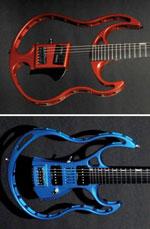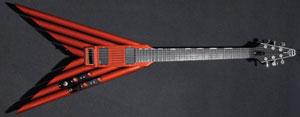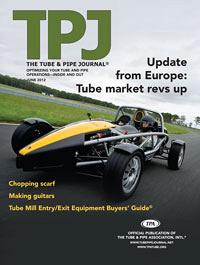- FMA
- The Fabricator
- FABTECH
- Canadian Metalworking
Categories
- Additive Manufacturing
- Aluminum Welding
- Arc Welding
- Assembly and Joining
- Automation and Robotics
- Bending and Forming
- Consumables
- Cutting and Weld Prep
- Electric Vehicles
- En Español
- Finishing
- Hydroforming
- Laser Cutting
- Laser Welding
- Machining
- Manufacturing Software
- Materials Handling
- Metals/Materials
- Oxyfuel Cutting
- Plasma Cutting
- Power Tools
- Punching and Other Holemaking
- Roll Forming
- Safety
- Sawing
- Shearing
- Shop Management
- Testing and Measuring
- Tube and Pipe Fabrication
- Tube and Pipe Production
- Waterjet Cutting
Industry Directory
Webcasts
Podcasts
FAB 40
Advertise
Subscribe
Account Login
Search
Guitar-maker branches out with new designs
No tube too unusual for Gordon Branch
- By Eric Lundin
- June 13, 2012
- Article
- Tube and Pipe Fabrication
Gordon Branch built his first guitar as a teenager when he longed for an instrument he couldn’t afford. His goal was to build one acoustic guitar for his own use. The goal was ambitious but not outlandish, considering his background. He had attended high school in the late 1970s, when vocational programs were plentiful and rewarding manufacturing jobs were easy to come by. He had the righteducational background and the mechanical aptitude.
Setting a goal is one thing, but achieving it is something else altogether. It turned out that Branch’s solution to his problem, which involved taking a class from master luthier Ervin Somogyi, presented a new problem for Branch to solve. Like the guitar, the class was too expensive. Branch’s creative streak solved this problem too: He offered to make Somogyi a set of tools for building guitars instead of paying the tuition. Somogyi agreed, and before long Branch was the owner of an acoustic guitar built with his own two hands. He still has it, but 30 years later his focus is less on playing and more on making novel and interesting designs, mainly in metal, often from tube.
Woods and Metals
Although today he works from a home workshop in the Sierra Nevada mountains of Northern California, Branch got started building guitars decades ago while he was working for a manufacturer in San Francisco. His job provided quite a bit of freedom. He was the only machinist in a facility that employed more than 1,000 people, so he could do some moonlighting without drawing much attention. Whenhe decided to make a guitar body from a billet of aluminum, he stayed late and machined it at work.
This was a huge departure from conventional guitar designs, which use wood for both acoustic and electric models. In addition to being unique, it’s versatile (see Figure 1).
He eventually left that position and went to work for a small machine shop, where he occasionally worked with tube. Anyone who handles tube knows that it rings when struck, and this didn’t escape Branch’s attention. He thought tube’s acoustic properties would work well for a guitar.
“I wanted a totally original design,” Branch said. “I wanted a modern, industrial look, and I thought tubing would get me there. I started coming up with very angular designs, and when I had one finalized, I named it AirTube V.” (See Figure 2.)
Branch’s hunch panned out. The guitar has sound characteristics like no other.
More Shapes
His next design took the tubular concept further, relying on rectangular billets and round tubing. It didn’t develop from a flash of inspiration; it took quite a bit of time to take shape.
“I draw and erase and draw and erase and draw and erase,” Branch said. “Sometimes I hang a half-finished drawing on the wall and wait for inspiration to strike.” It was this process that led to the guitar he named The 331⁄3 Degree (see lead photo). Harking back to the days when vinyl records were the main music medium, the name also is the angle of the aluminum billet at thefront of the body. Two aluminum billets, one at the front and one at the back, are connected by horizontal lengths of round tubing.
Design and Assembly
Through the course of building guitars from unique designs, Branch has applied quite a few things he learned over the years as a machinist. Still, more than 20 years of experience didn’t prepare him for everything. Branch’s career as a luthier has been one of experimenting and problem-solving.

Figure 1: An early Branch design has a single pickup (top). A subsequent design has more material in the center section, providing more support (bottom). In addition to holding two pickups, it’s a sturdier instrument.
The AirTube V. The AirTube V’s design is elegant and sleek. It has all the features you’d expect to find on a guitar like this—a body, a neck, a bridge to anchor the strings, two pickups (which turn the string’s vibrations into electrical current), and control knobs. However, the AirTube V also has an additional feature, a small panel on the back of the body. This panel gave the welder accessto the inside of the billet that serves as the instrument’s body. This is the design feature that made the AirTube V work. Without it, it would have been impossible to assemble. In other words, the guitar is lacking one feature you would expect to find: visible welds.
The 331⁄3 Degree. The 331⁄3 Degree is a different animal altogether. This design didn’t lend itself to hiding the welds, so Branch learned how much work goes into grinding down welds. Because he was going for an aesthetic look on par with AirTube V, Branch had to take the welds down completely by grinding them and polishing, polishing, and polishing some more until the weld area couldn’t bedistinguished from the parent material.
He started the work with a power tool, but on occasion he lost control of it and put grind marks where they didn’t belong. Branch soon tired of repairing errant grind marks, so he resorted to doing the rest of the grinding by hand. While he acknowledges that it turned out to be more work than he planned, at least 40 hours, he found that the clean look made all the effort worthwhile.
Airfoil Shape. While browsing through a metal shop, Branch happened to see a length of tube in the shape of an airfoil. He didn’t have any particular plans for using it, but bought a 6-ft. length anyway because he thought it had potential. As he worked up the design for it, he gave a lot of thought to the welds, especially the grinding and polishing process. He wondered if he could eliminatethem.
“I looked into dip brazing,” Branch said. “After assembling the instrument, it would be dipped into a salt bath 100 degrees below the melting point of the aluminum, but above the melting point of the flux. The flux would fill in the gaps between the components, bonding them after it cooled.” The big drawback was that Branch would have to make all the holes oversized by 0.010 inch, and thatwould have left too much to chance. He couldn’t be sure if the instrument would come out straight.
After he decided to design it for gas tungsten arc welding (GTAW) assembly, he still had to figure out how to make two airfoil-shaped holes in the front billets. One of the tube-billet intersections had no weld, so he needed a good fit for a good look. A gap would be unsightly. Making a hole shaped like an airfoil on his mill wouldn’t be a possibility, so once again Branch affirmed the valueof hand tools and elbow grease.
“I had to file it by hand,” he said. “I used a grease pencil to mark the tube, then slid it into the opening, looking for the spots where the grease rubbed off.” The patience paid off (see Figure 3).
What’s Next?
Off-the-shelf tube comes in an endless variety of shapes—oblong, obround, hexagonal, octagonal, slotted obround, triangular, and on and on. What’s next for Gordon Branch? It’s hard to say, but considering that he plunged right in when he saw the unique airfoil-shaped tube, anything is possible.
About the Author

Eric Lundin
2135 Point Blvd
Elgin, IL 60123
815-227-8262
Eric Lundin worked on The Tube & Pipe Journal from 2000 to 2022.
About the Publication
subscribe now

The Tube and Pipe Journal became the first magazine dedicated to serving the metal tube and pipe industry in 1990. Today, it remains the only North American publication devoted to this industry, and it has become the most trusted source of information for tube and pipe professionals.
start your free subscription- Stay connected from anywhere

Easily access valuable industry resources now with full access to the digital edition of The Fabricator.

Easily access valuable industry resources now with full access to the digital edition of The Welder.

Easily access valuable industry resources now with full access to the digital edition of The Tube and Pipe Journal.
- Podcasting
- Podcast:
- The Fabricator Podcast
- Published:
- 04/16/2024
- Running Time:
- 63:29
In this episode of The Fabricator Podcast, Caleb Chamberlain, co-founder and CEO of OSH Cut, discusses his company’s...
- Trending Articles
Zekelman Industries to invest $120 million in Arkansas expansion

3D laser tube cutting system available in 3, 4, or 5 kW

Corrosion-inhibiting coating can be peeled off after use

Brushless copper tubing cutter adjusts to ODs up to 2-1/8 in.

HGG Profiling Equipment names area sales manager

- Industry Events
16th Annual Safety Conference
- April 30 - May 1, 2024
- Elgin,
Pipe and Tube Conference
- May 21 - 22, 2024
- Omaha, NE
World-Class Roll Forming Workshop
- June 5 - 6, 2024
- Louisville, KY
Advanced Laser Application Workshop
- June 25 - 27, 2024
- Novi, MI




























